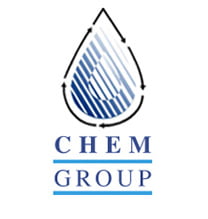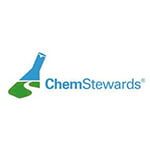Full-Circle Supply and Services for Heat Transfer Fluids
CHEM Group is the only one-stop shop for all your high-performance heat transfer fluids (HTF) supply and services.
Over the last 25+ years, we’ve worked with hundreds of clients, helping their systems run smoothly and efficiently.
We only offer the most economical and cost-effective “Full-Circle” heat transfer products and services to help you identify the best fluid for your system and optimize your process operations to maximize your heat transfer fluid performance.
CHEM Group takes the time to understand your specific requirements and create custom programs that not only optimizes your system’s performance but saves you money.
You can trust our knowledgeable and experienced professionals to assist you in troubleshooting fluid issues and offer affordable solutions to your HTF system.
Click here to learn more about heat transfer fluids.
Click here if you are looking for our heat transfer fluid reclamation services.
Check Out Our HTF Products
Thermaflo®
The Thermaflo product line is Chem Group’s exclusive recycled products, designed to provide high-end performance, low environmental impact, and great cost savings. These fluids meet OEM requirements and are compatible with fluids of similar chemistries.
MARLOTHERM®
MARLOTHERM® products have been used in the chemical process industry for almost 40 years. Chem Group is the exclusive distributor for Marlotherm® heat transfer fluids in the United States and Canada.
View MARLOTHERM® products here
CALFLO™
Chem Group is an authorized distributor of Petro Canada’s CALFLO™ line of heat transfer fluids. These fluids are compatible with non-pressurized, liquid phase, closed heat transfer systems, and operate at a wide range of temperatures.
An Overview Of Heat Transfer Fluids
Want to learn more about what heat transfer fluids are and what they can do for you?
Read on.
What is a heat transfer fluid?
A heat transfer fluid (HTF) is any gas or liquid that transfers heat from one system to another in order to heat, cool, or maintain a constant temperature.
All systems have different requirements and will need different heat transfer fluids as a result.
However, there are commonalities that you can look for when purchasing transfer fluids for your system.
An ideal HTF should have:
- High boiling point – low vapor pressure
- Low pour point and viscosity for ease of cold temp start-up
- Good thermal stability at operating temperatures
- Good heat transfer properties
- Non-corrosive to common materials of construction
- High flash point and auto-ignition temperature
- No/ minimal regulatory constraints
- Low toxicity and skin irritation
- Low cost over the service life of the fluid
How does heat transfer fluid work?
What happens when (baking a chocolate cake, for example) a cook attempts to melt a bar of chocolate in a pan that has direct contact with a heat source?
- The chocolate bar melts easily and evenly
- The chocolate bars melts unevenly and burns to the pan
- The chocolate bar remains a solid
- None of the above
The answer is B. The chocolate bar melts unevenly and often burns to the pan making a mess.
However, melt the same bar of chocolate bar on the same heat source using a double-boiler with water in the bottom pan, the answer is A… The chocolate bar melts easily and evenly.
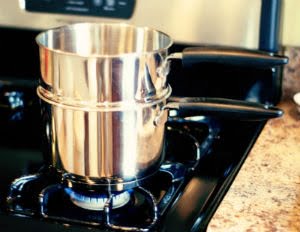
The water transfers the heat evenly and thoroughly to the upper pan, resulting in an even melt and consistent temperature preventing the chocolate bar from melting.
Heat transfer fluids in your system work the same way by allowing heat to be distributed evenly.
Does water make a good transfer fluid?
As it has most of the properties as an ideal heat transfer fluid (and was used in the example above), water would seem to be a great candidate for a heat transfer fluid.
However, though water has good thermal conductivity and thermal capacity, at higher temperatures it is highly unstable and its steam can react with the walls of the container making it vulnerable to rusting.
For these reasons, water is not an ideal heat transfer fluid for your system.
Are there HTFs that are better suited for certain temperatures?
Certain industries and applications will either require extremely high or low temperatures, and it is best to use HTFs that are suited for these conditions.
So what’s the difference between high and low temp transfer fluids?
A high temperature HTF has a high boiling point and low vapor pressure.
They have high flash points and high thermal capacity.
Since high temperature HTFs are subjected to high temperature, the life span of these HTFs decrease considerably when frequently used.
Moreover, high temperatures above their max limit cause these HTFs to crack and form larger molecular carbon compounds.
This leads to the formation of sludge inside pipework and flow passages, reducing efficiency.
For this reason, it is important to test your fluid periodically.
Flushing and replacing your fluid is often less expensive than having to purchase replacement parts or a whole new system.
A low temperature HTF has low viscosity, low pour points, good thermal capacity, a wide temperature range, stability at extremely low temperatures, high dielectric, and lower molecular weight.
They are typically used for heating systems that operate in cold climatic conditions, food and beverage industries, cooling foods and dairy products, and immersion freezing units.
What is an HTF used for?
The primary purpose of using transfer fluids in a system is to transfer heat from one system to another.
This principle is applied to either heat a system by transferring heat to it or cool a system by constantly removing heat from it.
Under controlled flow, it can be used to maintain a constant temperature by regulating the flow of HTF.
Any system that needs to be heated or cooled consistently uses an HTF to achieve the desired temperatures.
To give you an idea of what systems use transfer fluids, check out the industries and applications below.
i. Polyester and Synthetic Fibers manufacturing.
 A polyester and synthetic fiber manufacturing unit prepares fibers using processes like polymerization, melting, extension and drying.
A polyester and synthetic fiber manufacturing unit prepares fibers using processes like polymerization, melting, extension and drying.
These processes need a relatively high and stable temperature to function.
A heat transfer fluid provides stable and accurate heat to these systems safely.
Effective functioning of these processes depends on constant temperature, efficient heat transfer and stable heat flow by heat transfer fluids.
ii. Oil and Gas
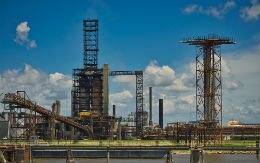 Many stages of oil and gas production need heat transfer fluid including initial production, transport, refining, and recycling.
Many stages of oil and gas production need heat transfer fluid including initial production, transport, refining, and recycling.
During regeneration of glycols in offshore plants, HTFs are used to help remove water content from the natural gas formed.
Oil refineries distill many oils and oil-based products by heating boilers, reactors, storage tanks and columns using heat transfer fluids.
Oil distillation and pump stations along oil pipelines require very high temperatures to maintain the viscosity of oil for smooth pumping of oil through pipes.
HTFs are used to provide high temperatures in these distillation and pump stations.
iii. Chemical industry.
 Certain chemicals require heat transfer for indirect heating when being processed.
Certain chemicals require heat transfer for indirect heating when being processed.
The heat is used in many areas, including pipeline tracing, energy recovery, low pressure co-generation, drying and heating of bulk materials.
These processes require specific temperatures using the right heat transfer fluids that reduce coke formation on the internal pipes and passages.
Using consistent heat helps create a stable environment for chemical reactions, purification, desiccation, rectification, solvent production, and heat preservation.
iv. Pharmaceutical industry.
 Pharmaceutical processing needs to provide specific temperatures for prolonged periods to heat as well as cool the products.
Pharmaceutical processing needs to provide specific temperatures for prolonged periods to heat as well as cool the products.
High temperatures may cause chemical reactions to products and low temperatures cause crystallization of them.
It’s important to note, you need to use food-grade heat transfer fluids for processing pharmaceuticals.
These HTFs have a high chance of being in contact with the products being made, and therefore need to be safe.
v. Coal Chemical industry.
 The coal industry uses processes such as tar fraction, benzol hydrogenation, anthraquinone production, reactions, distillation, and rectification; all requiring high temperature to run.
The coal industry uses processes such as tar fraction, benzol hydrogenation, anthraquinone production, reactions, distillation, and rectification; all requiring high temperature to run.
A wide range of temperature with stable heat under low pressure and high conductivity is needed for these processes in the coal industry to run efficiently.
vi. Plastic and rubber.
 Plastic and rubber industries need to achieve uniform polymerization and condensations of polyester, nylon and rubber products.
Plastic and rubber industries need to achieve uniform polymerization and condensations of polyester, nylon and rubber products.
In molding, extrusion, press heating, coating rolls, and vulcanizing, you need to have precise temperatures to form a solid product.
An HTF with high stable heat, anti-oxidative, non-fouling and a nontoxic nature is needed to provide these required temperatures.
vii. Metal machinery and castings.
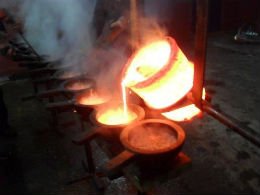 Metal machinery and castings have high heating requirements in electroplating, spray drying, rolling, baking and molten casting.
Metal machinery and castings have high heating requirements in electroplating, spray drying, rolling, baking and molten casting.
HTFs used in machinery and casting industry need to have low carbon sludge, low acid value and coking resistance to transfer heat efficiently.
Using such HTFs will result in lower maintenance needs and increased functional period of your equipment.
viii. Desalination of seawater.
 Seawater desalination plants work by evaporating seawater and cooling the vapors to form water.
Seawater desalination plants work by evaporating seawater and cooling the vapors to form water.
The efficiency and cost of running a desalination plant highly depends on the exchange of heat efficiently without loss of heat to the atmosphere.
It is very important that the transfer fluid conducts heat effectively for the desalination plant to work efficiently.
Among the various optimization processes in desalination, efforts are taken to maintain a maximum exchange of heat.
An HTF for desalination plants should have high conductivity, low corrosion and be nontoxic.
ix. Storage and Transportation.
 Certain chemical products, such as asphalt, need to be stored and transported by maintaining a constant temperature in their containers to avoid any reactions.
Certain chemical products, such as asphalt, need to be stored and transported by maintaining a constant temperature in their containers to avoid any reactions.
Such storage container’s temperatures are maintained using transfer fluid to maintain a required range of temperature during storage and transport of the chemical.
x. Food and beverage processing.
 Vegetable oil deodorizing, food additive manufacturing, food packaging, and preparation need liquid and vapor phase heat transfer fluids.
Vegetable oil deodorizing, food additive manufacturing, food packaging, and preparation need liquid and vapor phase heat transfer fluids.
Where steam-based HTFs cannot be used in certain processes, synthetic HTFs which are food-grade can serve the purpose.
Food and beverage industries use HTFs in heat exchanges to absorb from the product or transfer heat to it.
xi. Biofuel production
 When biomass is heated or cooled with prolonged and fixed temperatures, it yields biofuel such as ethanol, bio-diesel, and other fuels.
When biomass is heated or cooled with prolonged and fixed temperatures, it yields biofuel such as ethanol, bio-diesel, and other fuels.
The units producing biofuel need precise temperature for optimum yield.
The HTFs used to provide and control heat needs to be anti-oxidative to avoid any reaction with carbon.
xii. Cannabis industry
 HTFs are used in the cannabis industry to help maintain a constant temperature while extracting from and/or distilling cannabis.
HTFs are used in the cannabis industry to help maintain a constant temperature while extracting from and/or distilling cannabis.
Without proper temperatures, the products can become inconsistent and ineffective.
Looking to purchase heat transfer fluids?
Now that you’ve learned about what heat transfer fluids are and what industries they are used in, you should have a base idea of what fluids you need for your system.
Need help choosing the correct heat transfer fluid or want to place an order?
Give us a call at 1-800-489-2306 or click here to contact us.
